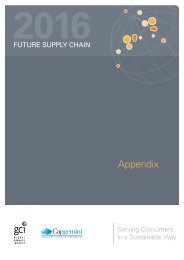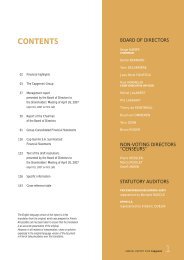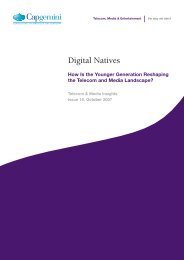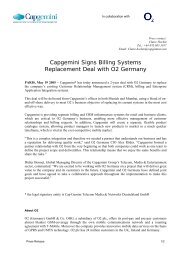Transportation Management Report 2011 - Capgemini
Transportation Management Report 2011 - Capgemini
Transportation Management Report 2011 - Capgemini
You also want an ePaper? Increase the reach of your titles
YUMPU automatically turns print PDFs into web optimized ePapers that Google loves.
7<br />
Because the form and shape of<br />
a company’s value chain alters<br />
almost daily, short- and mid-term<br />
logistics planning becomes very<br />
important. The planning of the<br />
optimal distribution network is an<br />
ongoing process that needs constant<br />
attention. Many networks are set<br />
up by tradition and over time may<br />
need to be changed in order to fit a<br />
more current situation. Distribution<br />
network analysis makes sure that<br />
warehouses and hubs are placed<br />
in optimal locations and the use of<br />
advanced software tools for daily<br />
route planning helps shorten the<br />
distances travelled to the customers.<br />
Where to locate a split point or the<br />
strategy behind FTL/LTL decisions<br />
will influence distribution costs and<br />
must be constantly monitored to<br />
make sure they match the current<br />
needs of the supply chain.<br />
Consolidation of shipments is one of<br />
the easiest ways to increase utilization<br />
of trucks and lower emissions.<br />
Keeping track of orders to suppliers<br />
and consolidating customers’ orders<br />
will reduce transportation costs<br />
significantly over time. <strong>Transportation</strong><br />
and warehousing activities must<br />
be in sync in order to consolidate<br />
shipments and reduce inventory<br />
levels. Therefore both transportation<br />
and warehousing activities should be<br />
aligned through common planning<br />
processes.<br />
The effects of careful logistics<br />
planning will be even more powerful<br />
if the planning is carried out together<br />
with suppliers and customers. This<br />
type of collaboration will make sure<br />
that every part of the value chain<br />
knows when to do what. The result<br />
is a more visible and flexible supply<br />
chain that is easier to manage.<br />
A leading consumer electronics<br />
producer introduced Collaborative<br />
Planning, Forecasting and<br />
Replenishment programs with several<br />
customers, which increased forecast<br />
accuracy to above 80% and reduced<br />
stock levels in their distribution<br />
network by more than 30%.<br />
Selecting the appropriate mode<br />
of transport<br />
‘Going green’ often makes the costs<br />
for transportation decrease. Choosing<br />
sea transport from Asia instead of<br />
air freight, or trading road transport<br />
for railway or short sea can, in many<br />
cases, lower the cost of transportation<br />
significantly. Of course, in the case<br />
of trading air freight for the much<br />
slower sea alternative, it will affect<br />
the amount of safety stock you need<br />
to carry but maybe, in this time of<br />
cost pressure and focus on green<br />
issues, this should be part of the<br />
consideration. The total logistics<br />
cost is, of course, the thing to keep<br />
in mind. By increasing competition<br />
among suppliers and decreasing<br />
their air volumes from 60% of total<br />
freight volumes to 30% and shipping<br />
the difference by sea, Ericsson, the<br />
telecom company, expects to see a<br />
40% reduction in their international<br />
distribution costs.<br />
Railway and intermodal transport<br />
can help minimize the environmental<br />
impact of transportation and can<br />
cut costs if the distance is long<br />
enough and reloading can be kept<br />
to a minimum. Volvo Cars has<br />
implemented a train solution for<br />
their transportation of goods from<br />
Germany to Sweden and have<br />
lowered their transportation costs in<br />
this area by 15% with just slightly<br />
longer lead times.















